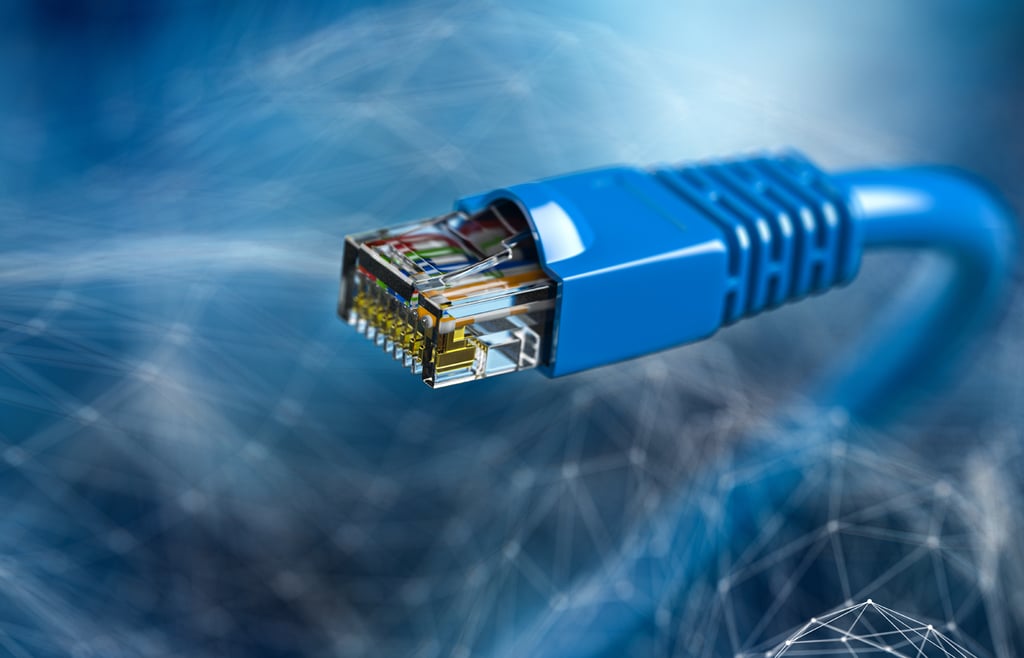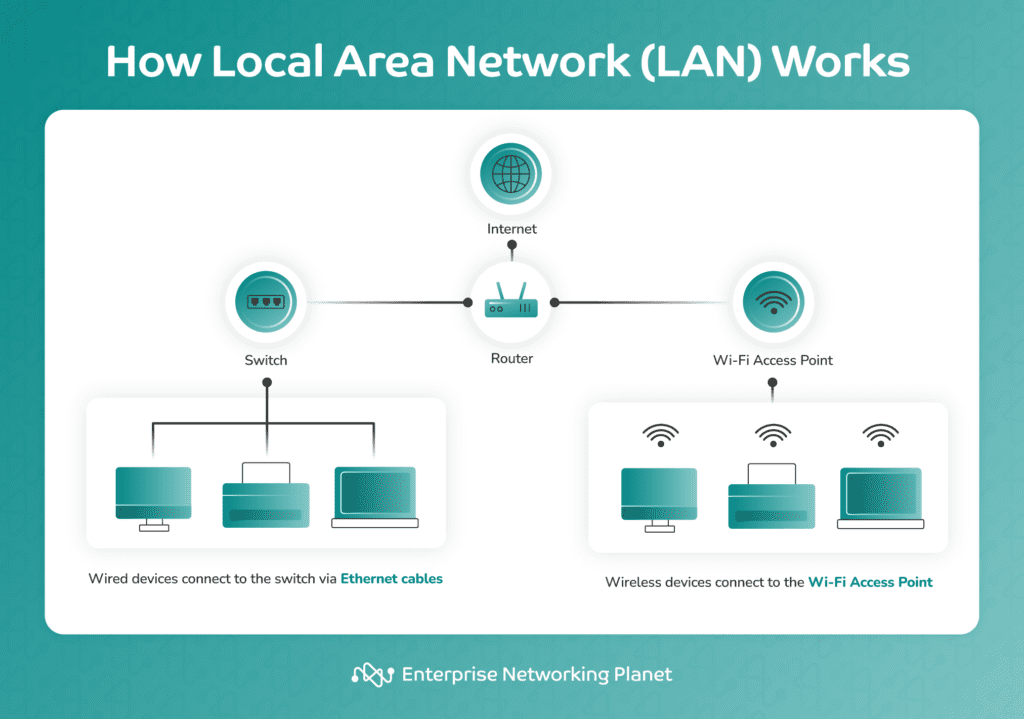

Image: Maksym Yemelyanov/Adobe Stock
Local area networks (LAN) are used to connect devices such as computers, servers, and printers within a limited geographic area. Here’s how they work.
A local area network (LAN) is a network that connects computers and devices within a limited geographical area, such as a home, office, or educational institution. Understanding the local area network definition is key to grasping how these networks aid in the sharing of various resources, including files, printers, and internet access, and support user-to-user communication.
LANs can vary significantly in size, ranging from small networks connecting only a few devices to large networks linking hundreds or even thousands of devices. One of the advantages of LANs is that the size of a LAN does not affect its fundamental functionality, as all LANs provide the capability for resource sharing and interpersonal communication.
Today, LANs play a crucial role in streamlining connectivity, information exchange, and resource accessibility. Here’s how they work, their benefits and challenges, how they compare to other network types, and other FAQs.
LANs function through central points called routers to connect to the Internet. Home LANs generally use a single router, while larger LANs may employ network switches for smooth packet delivery.
Aside from establishing connections between LANs and allowing devices on different networks to communicate seamlessly, routers also strengthen network security by filtering and blocking unwanted network traffic.
LANs typically utilize Ethernet, Wi-Fi, or a combination of both to connect devices within the network. Ethernet uses physical cables for connections, while Wi-Fi operates through radio waves. The latter has gained popularity in residential and corporate settings due to its convenience.
Various devices, including servers, desktops, laptops, printers, internet of things (IoT) devices, and game consoles, can establish connections to LANs. These connections permit shared access to resources like printers or servers, a feature particularly useful in office environments.

There are two main types of LANs: client-server LANs and peer-to-peer LANs.
Client/server LANs link multiple devices, known as clients, to a central server. This server manages file storage, application access, device access, and network traffic.
In this configuration, the server governs the network traffic and resources. It provides shared access to files, printers, and the internet. A variety of network-enabled devices, such as desktop PCs, tablets, and smartphones, can serve as clients in this network.
Client/server LANs give significant network control, making them particularly suitable for larger networks. However, establishing and maintaining these LANs can pose more challenges. The server is a key dependency — its failure could trigger a network-wide failure.
Client/server LANs are ideal for business environments, large organizations, database management, security and access control, and centralized backup.
Peer-to-peer (P2P) LANs don’t have a central server and cannot handle heavy workloads like a client/server LAN can, and so they’re typically smaller. For this LAN type, each device shares resources and data equally through wired or wireless connections to a switch or router.
Every device in P2P LANs can act as both a client and a server, making it simpler to set up for small-scale networks, like home environments or small offices. This simplicity also means this architecture does not require any special network software. In addition, P2P LANs are more reliable in the sense that they do not rely on a central server — if one computer fails, it does not cause a failure of the entire network.
The drawback of P2P LANs is that they lack centralized control and advanced security features compared to client/server architectures.
P2P LANs are frequently used where minimal infrastructure is acceptable, e.g., home networks, small offices, temporary or ad-hoc networks, learning environments, and file sharing:
LAN brings several benefits to your business, including resource sharing; remote collaboration; cost-efficiency; high-speed data transfer; better security, flexibility, and scalability; centralized control; and backup and disaster recovery.
Using LAN comes with several challenges, including security concerns, network traffic management, scalability, costs, interoperability, mobility and remote access, and technical complexity.
The following are examples of use cases illustrating what a local area network is and showcasing their importance in various settings, from offices and homes to schools and healthcare facilities.
In a corporate office, LANs connect employee workstations, printers, and servers. This allows employees to collaborate on documents, access centralized databases for customer information, and print documents to a shared printer. LANs streamline workplace productivity and information flow.
In a typical home, a LAN connects family members’ computers, smartphones, smart TVs, and gaming consoles. This lets them stream movies, share photos and files, and access the internet via a single connection. Home LANs make it convenient for everyone to connect and share resources.
In a school setting, LANs connect computer labs and classrooms. Teachers use LANs to access digital teaching resources and share lesson materials with students. Students can also collaborate on group projects using LAN-connected devices, promoting interactive and engaged learning.
A small retail store can utilize a LAN for its point-of-sale (POS) systems. The central server connects to the cash registers, records sales transactions, manages inventory in real-time, and securely stores customer data. By optimizing operations and refining customer service, LANs boost the efficiency of small businesses.
In multinational corporations, LANs link numerous devices dispersed across diverse global offices. Through LANs, employees tap into centralized databases for cooperative projects, share confidential company data securely, and interact effortlessly via email and messaging systems. By supporting effective data exchange and teamwork, enterprise LANs greatly elevate organizational performance.
In a hospital, LANs connect medical devices like patient monitors and electronic health record (EHR) systems. Doctors and nurses safely access confidential patient data, and medical devices transmit real-time patient information to EHRs for immediate monitoring and decision-making. Healthcare LANs improve patient care and simplify medical data management.
The comparison chart below shows an overview of the key differences between LAN, wide area network (WAN), and metropolitan area network (MAN). It gives a glimpse of the geographic scope, technologies used, ownership, coverage, and examples for each.
| Attribute | LAN (Local Area Network) | MAN (Metropolitan Area Network) | WAN (Wide Area Network) |
|---|---|---|---|
| Geographic scope | Small area, e.g., room, single building, or campus | Larger area, like a city or a large campus | Large area, can span entire countries or continents |
| Technologies used | Ethernet, Wi-Fi, and other high-speed technologies | Combination of technologies, e.g., fiber optics and wireless | Multiple technologies, including leased lines, satellite links, and internet |
| Ownership | Owned and operated by a single organization | Owned and operated by a single organization or a collaboration between multiple entities | Owned and operated by multiple organizations, service providers, or part of the public internet |
| Coverage | Usually within a few hundred meters to a few kilometers | Typically covers a few kilometers up to tens of kilometers | Spans long distances, often involving thousands of kilometers or more |
| Examples | Home network, office network, school network | Municipal Wi-Fi network, university campus network | Internet, global corporate networks, intercontinental data connections |
The security of LANs is a complex issue that hinges on several factors, namely access control, firewalls, encryption, antivirus, regular updates, intrusion detection systems, physical security, and user education.
LAN security is an ongoing process that demands different technical measures, vigilant management, and user awareness to effectively shield against potential threats. LANs face several security risks, including unauthorized access, malware, data theft, phishing, physical security breaches, and denial-of-service (DoS) attacks.
At the heart of LAN security are access control measures, which ensure that only authorized users can enter the network, mostly through robust password policies and specific access permissions. Packet-filtering firewalls also play an indispensable role by controlling network traffic and protecting against cyberattacks.
Furthermore, using encryption techniques safeguards data transmission and maintains confidentiality. Antivirus software and regular updates are also imperative in defending against malware while intrusion detection systems keep an eye on and respond to any suspicious activities. Additionally, implementing physical security measures, like restricting access to network equipment, holds significant importance.
Finally, an intrinsic part of LAN security is educating users to follow security best practices.
LAN has developed dramatically since its beginnings thanks to improvements in security and manageability, and of course the advent of wireless connectivity. Throughout these changes, it has remained a critical aspect of many organizations’ network infrastructure.
While a client-server model is typically the trusted approach for larger enterprises, homes and small offices may benefit more from a P2P approach. On the other hand, if your network has to cover a large campus or across borders, you may want to consider a MAN or WAN, respectively, instead — or a combination. Whatever you choose to go with, make sure you plan your implementation accordingly — including long-term monitoring, management, and security.
If you’re ready to take the next step in setting up a LAN at your organization, we analyzed the top enterprise LAN providers to help you choose the best option for you.
Liz Laurente-Ticong is a tech specialist and multi-niche writer with a decade of experience covering software and technology topics and news. Her work has appeared in TechnologyAdvice.com as well as ghostwritten for a variety of international clients. When not writing, you can find Liz reading and watching historical and investigative documentaries. She is based in the Philippines.

Enterprise Networking Planet aims to educate and assist IT administrators in building strong network infrastructures for their enterprise companies. Enterprise Networking Planet contributors write about relevant and useful topics on the cutting edge of enterprise networking based on years of personal experience in the field.
Property of TechnologyAdvice. © 2025 TechnologyAdvice. All Rights Reserved
Advertiser Disclosure: Some of the products that appear on this site are from companies from which TechnologyAdvice receives compensation. This compensation may impact how and where products appear on this site including, for example, the order in which they appear. TechnologyAdvice does not include all companies or all types of products available in the marketplace.